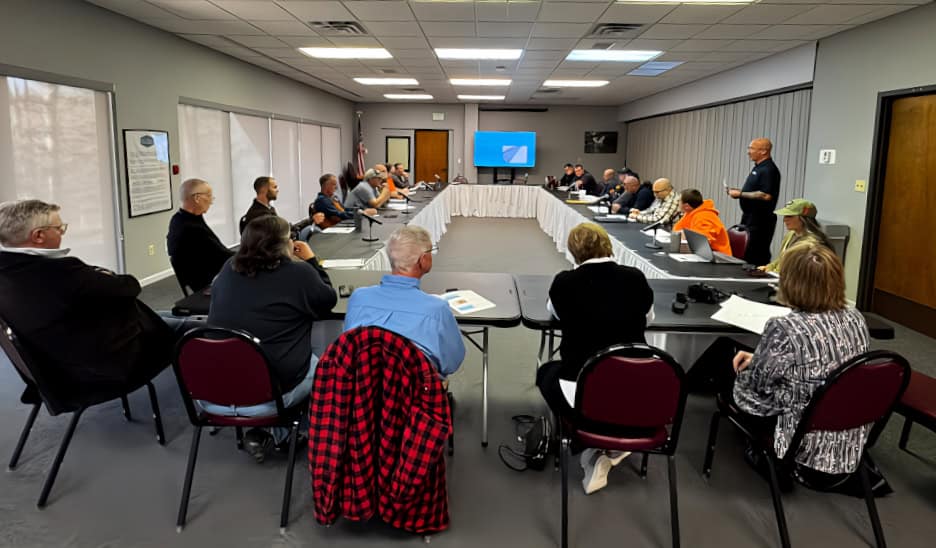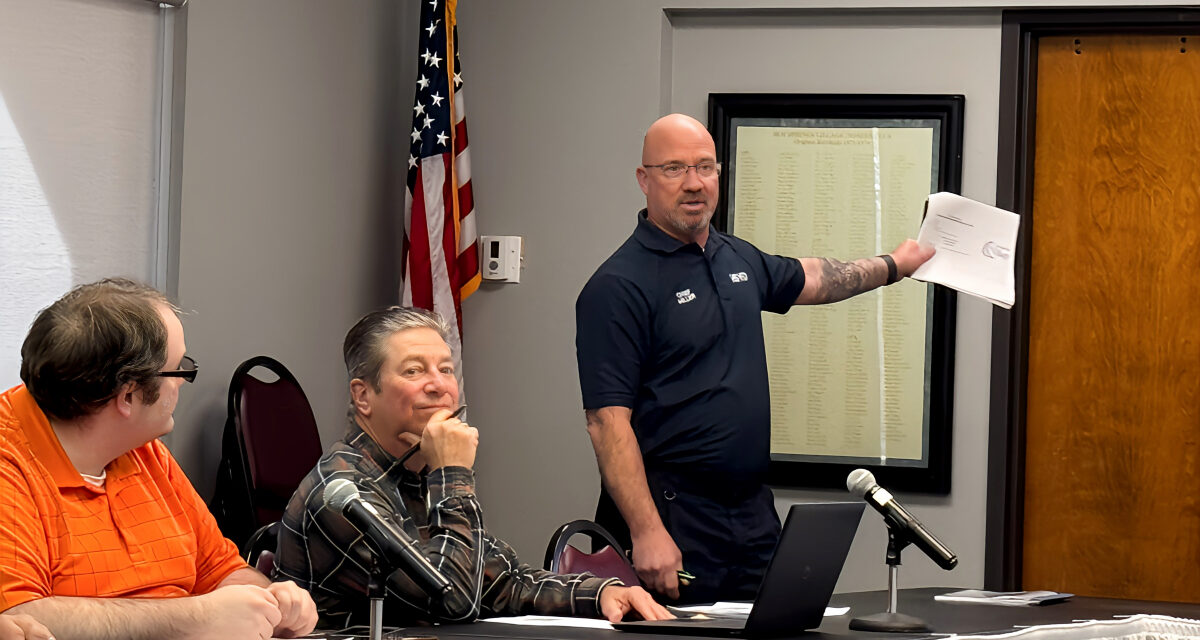The Hot Springs Village POA is prepping ahead to keep our community safe in case of snow and ice!
A snow and/or ice weather event could precipitate the closing of the POA Administration Office, delay sanitation services, and lead to the closure of amenities and other POA facilities. Roads could become difficult or even impossible to navigate, making travel challenging for first responders, POA staff, and motorists. If electricity is lost, water pipes at buildings could freeze, and the list goes on.
Because staff and emergency services need to be prepared in advance to handle such an event, the Hot Springs Village POA held an Ice and Snow Preparedness Meeting on Friday, January 3, 2025. It appears the scheduling of this meeting may have been timely because, according to weather services, we expect snow on Thursday, January 9, and Friday, January 10. Weather forecasts are not always accurate, so let’s hope not, but time shall tell.
Facilitated by HSV Fire Chief Jason Miller, the meeting was well attended by appropriate first responders and POA staff. Below are notes from a tabletop exercise with staff and emergency services offering planning input and recommendations on procedures for handling a snow/ice event in Hot Springs Village. Please remember that the following account is fictitious, but something similar or even more severe could happen. Also, note that this report is a condensed version of the meeting, with some of my thoughts at the end. Let’s begin the tabletop exercise.

Hypothetical scenario
In the last few days, the local news and weather services called for snow during the evening hours of Tuesday, January 28, 2025. The forecasters mention that it will only be a dusting to an inch in the central part of Arkansas.
What will we do In preparation?
Preparation begins even before the storm arrives as a flurry of activity commences. The scheduling of emergency staff is already being considered. Chains and straps are readied. Buildings are prepared to prevent freezing. Hoses are disconnected, and hose bibs are installed on outside water faucets. Water service to the buildings is not shut off at this point, but the temperature and possible electrical outages are being closely monitored. Years ago, the water pipes and sprinkler system burst at the DeSoto Club and 19th Hole because temperatures were below freezing, electricity was out for around two weeks, and the water service was not turned off. While the DeSoto Club has been restored, we lost the 19th Hole. The POA wants to prevent a similar situation from recurring.
Police and Fire Departments are always on call for emergencies. Studded tires are installed where needed. The Village is divided into four quadrants.
The Streets Department prepares for a worst-case scenario. If the weather calls for “dusting,” they assume it could be worse and have everything ready, just in case. Appropriate vehicles are serviced and checked to ensure everything is working. At this point, the sanders may not be loaded with a mixture of sand and deicer. The plows are ready to go. Crews are designated to work 12-hour shifts. During inclement weather or emergency events, the Streets Department operates two shifts – day and night.
The Hot Springs Village Emergency Operations Plan is activated as this weather system appears to be ramping up into a dangerous event. General Manager Ken Unger believes it is better to be safe than sorry. If it turns out the plan is not needed, no harm is done.
Key staff may be sent home with 4-wheel drive vehicles and will pick up other staff on their way to work.
Eblast communications to Villagers will be sent if needed.
Mother Nature leaves her winter chill.
Tuesday, January 28, during the night hours, at approximately 8:10 p.m., freezing rain begins and then turns to snow an hour later. It has been 28 degrees all day.
Employees are paired, as no one goes out by himself to sand or plow. An employee remains at the Minorca Facility to load the trucks with the proper mixture of sand and salt. Staff from other departments may be enlisted to ride along with the drivers.
Sand and deicer are applied to the streets, prioritizing the main roads, with some dangerous side roads also receiving treatment.
The Captain in Charge at the Police Department will conduct a road condition check around 3:00 or 4:00 a.m. and notify the police Chief.
The Fire Department personnel comes in early and remains for extended shifts. It can be dangerous for them to travel home and back again, so they remain on site.
Texts are sent out to key staff to announce that a Bridge, also known as a conference call, has been activated. This allows timely communication between departments and emergency services. Times are established for the Bridge calls. This can be as often as every two hours, depending on the situation.
Dangerous roads may be closed, using barricades and signs staged at possible problematic areas.
At 6:00 a.m. Wednesday morning, January 29, snow still falls after receiving approximately 4.5” overnight. At this point, sanding and salting have ended, and the crews are only plowing.
An Emergency Operations Center (EOC) and an Incident Command Center (ICC) have been established.
The EOC is for higher-level personnel and focuses on strategic-level coordination and support, coordinating resources, supporting incident command, and managing public information.
The ICC is for tactical-level control and management of the situation, directly managing the on-scene responses.
Decisions must be made by the General Manager whether to close POA facilities. If the GM is not available, the decision is made by the Public Services Director.
The Communications Department sends out Eblasts to property owners and residents. Motorists will be advised to stay home and off of the roads, along with other pertinent information. Communication with villagers and the press will continue throughout the day if necessary.
At 7:00 a.m., schools have canceled for the day. Currently, power seems to remain on throughout the village. Road crews report that more vehicles are starting to travel on the roadways.
At approximately 7:30 a.m., HSVPD dispatch starts receiving calls about vehicles in ditches.
Emergency services will respond to the calls and ensure the vehicles are off the roadway. Drivers of disabled vehicles will be given numbers to towing services.
At 9:00 a.m., reports show that fallen trees are across the roadways at multiple locations.
Crews respond to reports of fallen trees and debris on roadways and clear the roadway by moving the material off to the side for pick-up after the weather clears. If necessary, contractors may be called to assist.
At 3:00 p.m., the winter weather system leaves our area, and the sun is shining. It is now 34 degrees.
What remains to be done is to continue cleaning up fallen trees and debris, which will be transported to the Terlingua Pit for burning. If necessary, rescue crews will continue to respond to travelers who have had the misfortune of sliding off the road into ditches or even worse. Some of the roads will remain slick as the snow melts during the day but refreezes overnight, causing road conditions to remain dangerous in some areas.
Additional thoughts
In the above scenario, electricity in the Village remained on. If electrical service at certain POA buildings is lost, the scenario is a little different, with water service being shut off. Also, the EOC and IOC locations may need to be adjusted. While the POA owns a large generator and some smaller ones, there are not enough generators to power everything.
The Fire Stations are warming centers for Villagers who lose power. Please verify before going to a warming center.
The important thing is that while advance preparation is important, there is no way of knowing what variables Mother Nature may toss our way.
The POA will continue to hold yearly ice and snow preparedness meetings to update documents, provide staff with the latest information, and ensure everyone knows their role in this type of emergency. We can rest assured that Village first responders and staff are well-versed in snow and ice preparedness and ready to answer the call of the wild.
Snow events in the Village: uniquely challenging compared to other areas
Hot Springs Village has residents from various parts of the country where snowfall and ice are more common. Those communities are typically well-equipped with large budgets and expensive equipment to handle significant winter weather events. However, our community faces different challenges. Our curvy, often hilly roads become more hazardous, making it crucial to heed the POA’s advisories and avoid unnecessary travel on snowy and icy roads in the Village. Ignoring these advisories can result in costly mistakes and endanger your life, health, and that of others, including rescue workers.
Impacts on the community
Hot Springs Village is self-funded and receives no outside government funds in case of an emergency. A scenario such as the one above is costly in terms of additional staff compensation, supplies, and wear and tear on equipment. Our emergency fund account would fund an ice and/or snow event.
While a picturesque snow landscape may be beautiful to look at, the implications to the community could be injury and loss of life, and it is most certainly an expense we don’t need.
By Cheryl Dowden; Media by Joe Dowden
Click here to contact the HSV Gazette.
Click here to join our private Hot Springs Village Property Owners Facebook group. Be sure to answer the entry questions.
Click here to visit the POA website – Explore the Village.


